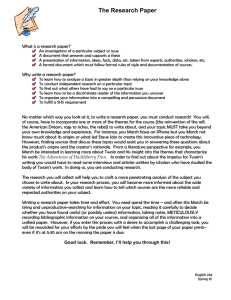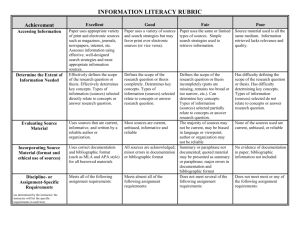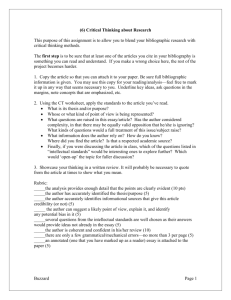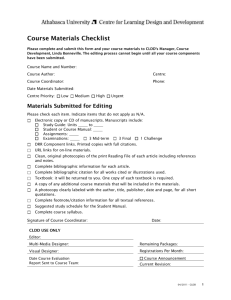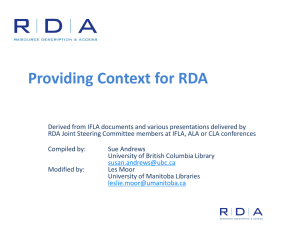Paris Principles, FRBR, and WEMI
advertisement
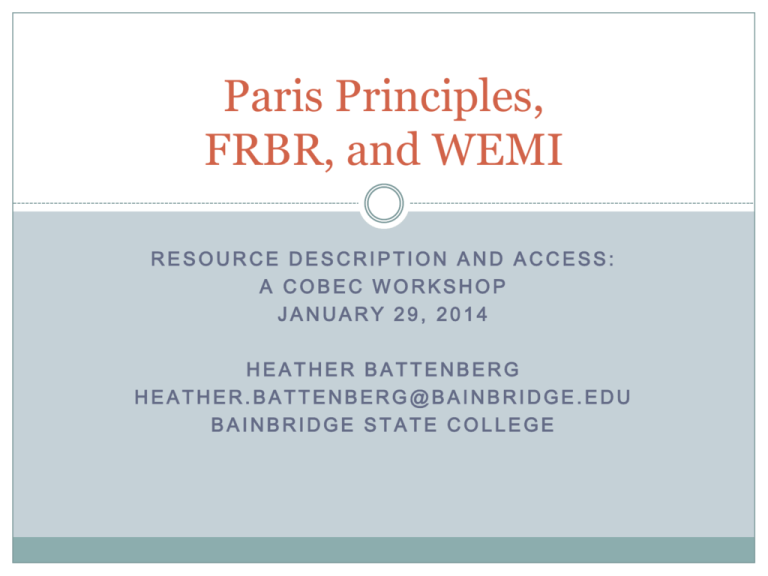
Paris Principles, FRBR, and WEMI RESOURCE DESCRIPTION AND ACCESS: A COBEC WORKSHOP JANUARY 29, 2014 HEATHER BATTENBERG HEATHER.BATTENBERG@BAINBRIDGE.EDU BAINBRIDGE STATE COLLEGE Paris Principles (1961) and ISBD Paris Principles (1961) Approved by the International Conference on Cataloguing Principles Scope Function Structure of the Catalogue Kinds of Entry Use of Multiple Entries Choice of Uniform Heading Single Personal Author Entry Under Corporate Bodies Multiple Authorship Works Entered Under Title, Uniform Headings for Works, etc. Entry Word for Personal Names International Standard Bibliographic Description (ISBD) International Bibliographic Description for Monographic Publications (1971) Codified the form and content of bibliographic description Facilitate the exchange of records internationally Universal bibliographic control Eight Areas of Description Title and Statement of Responsibility Edition Material or Type of Resource Specific Publication, Production, Distribution, etc. Physical Description Series Notes Resource Identifier International Federation of Library Associations and Institutions (IFLA) Statement of International Cataloguing Principles September 1997, amended and corrected through February 2008 Meant to align standard practice with the accepted rules Broadened the Paris Principles All types of materials, not just textual works Access through all aspects of bibliographic and authority records Built on FRBR, FRAR/FRAD, and FRSAR/FRSAD Not just the choice and form of entry “This first principle is to serve the convenience of catalogue users.” Made recommendations for an International Cataloguing Code IME ICC (July 2003) IFLA Meetings of Experts on an International Cataloguing Code Increase the ability to share cataloguing worldwide In order to achieve this, must promote cataloguing standards Stockholm Seminar on Bibliographic Records (1990) Arose from the Changing Environment of the Bibliographic Universe The expansion of automated systems The emergence of networked access to electronic information The rise of large-scale, international bibliographic databases The desire to eliminate duplicate cataloging efforts and reduce overall costs Shared cataloging Core/Basic cataloging records Simplified cataloging (minimum-level records) New forms of electronic publishing Publishing output greater than cataloging output Needed to respond more effectively to user expectations Adopted Nine Resolutions 1997 – Functional Requirements for Bibliographic Records (FRBR) Functional Requirements for Bibliographic Records (FRBR) Purpose To outline the function of a bibliographic record Media Applications Broad range of differing expectations and needs To recommend a basic functionality and basic requirements for bibliographic records that would meet essential user needs Addresses the Core/Basic record from the Stockholm Seminar Acquisitions, cataloging, circulation, information retrieval, interlibrary loan, inventory management, preservation, and reference User needs The full range of formats represented in bibliographic databases Identify what is necessary for less-than-full-level records without losing any functionality To produce a “framework” for the understanding of the functions and purpose of a bibliographic record Basic Bibliographic Records Providing a Foundation for Bibliographic Records Core elements that should be recorded “Attributes” or characteristics that are essential for describing works, expressions, manifestations, and items as it pertains to FISO Recording the intended audience “Relationships” that are essential when describing works, expressions, manifestations, and items as it pertains to FISO Recording the author Functional Requirements for Bibliographic Records Chapter 5 – Relationships Chapter 7 – Basic Requirements for National Bibliographic Records 7.3 – Basic Level National Bibliographic Record [core] The Framework To identify and clearly define . . . “entities” or objects of interest to users of bibliographic data “attributes” or characteristics of those entities “relationships” between those entities FRBR became the “conceptual model” for connecting attributes and relationships to user tasks User-Centered Approach What the user expects to find How the is data used Users Library patrons (including staff) Publishers, distributors, retailers Other users outside the library setting The FRBR Tasks (FISO) Find Based on user’s search criteria Identify Does the item retrieved match the item sought? Select Choosing a specific text in the preferred language Choosing a version that is compatible with the software used Obtain [or Acquire] Purchase a copy Borrow from another library Access an online version Retrieve the copy in the local library Objectives and Functions of the Catalog Improve the user’s experience in locating needed information Collocation: The catalog can display . . . All the works associated with a person, corporate body, or family All the expressions of the same work All the manifestations of the same expression All the items [or copies] of the same manifestation Circulation Placing holds not on a specific item or manifestation but on a work or expression Cut costs for the description of resources and facilitate access to them When libraries obtain new manifestations, they can link to existing works and expressions that are already present in the collection This saves time and effort because librarians can reuse subject analyses that have already been done to previous manifestations and apply them to new ones Position information providers to operate better in an Internet-driven environment and beyond FRBR Entities Key objects of interest to users of bibliographic data Divided into Three Groups Group 1 [title] Group 2 [author] “products of intellectual or artistic endeavor that are named or described in bibliographic records” Work, Expression, Manifestation, Item The “entities responsible for the intellectual and artistic content, production, dissemination, or the custodianship” Person, Corporate Body, Family Group 3 [subject] The subject of the endeavor Concept, Object, Event, Place FRBR and RDA FRBR Entities Can have multiple attributes Can have relationships with other entities RDA A large entity-relationship model Composed of entities, their attributes, and the relationships between them A work (entity) is created by (relationship) a person (entity) with particular birth and death dates (attributes). The work (entity) is also realized through (relationship) one or more expression (entities), which in turn are embodied in (relationship) manifestations (entities), each of which is published by (relationship) a publisher (entity) located at a particular address (attribute). In addition, the work (entity) may be an adaptation of (relationship) another work (entity) and may have another expression (entity) as its supplement (relationship). Group 1: WEMI WORKS “A distinct intellectual or artistic creation” The intangible intellectual product Abstract concept or idea Not yet manifested into something physical Bibliographic Records Primarily represented by an Authorized Access Point (AAP) For a title (130 or 730) 130 ;0_; $t Beowulf For a creator and title (1xx/240 or 7xx $a. $t.) 700 ;12; $a Morrison, Toni. $t Beloved. WORKS (cont.) Other MARC21 Fields that Represent a Work Standard Identifiers 046 – Special Coded Dates $k – Beginning or single date created $l – Ending date created [if applicable (i.e., for a series)] 380 – Form of Work 381 – Other Distinguishing Characteristics [attributes] 020 – ISBN 022 – ISSN 024 – Other Standard Identifier 046 ;__; $k 1965 130 ;0_; $a Harlow (Motion picture : 1965 : Douglas) 381 ;__; $a Douglas 380 ;__; $a Motion picture 8xx - Series EXPRESSIONS Still abstract The fulfillment of that idea through words, sound, image, etc. The physical “realization” of how the work will be communicated or transmitted Alpha-numeric script, musical notation, sound, visually, a three-dimensional object, symbols, etc. Example: A book in English Lang: eng A translation of the same book Lang: spa 041 ;1_; $a spa $h eng 240 ;10; $a … $l Spanish 546 ;__; $a In Spanish translated from English. EXPRESSIONS (cont.) MARC21 Fields that Represent an Expression Standard Identifiers 046 – Special Coded Date 020 – ISBN 022 – ISSN 024 – Other Standard Identifier $k – Beginning or single date created $l – Ending date created [if applicable (i.e., for a series)] 130/240 – Uniform Title $f – Date $k – Form subheading [manuscripts, protocols, selections, etc.] $l – Language [translation] $o – Arranged Statement for Music [arr.] 240 ;10; $t Corsaire; $o arr. $s – Version 130 ;0_; $t Qu’ran. $k Selections. $l English 240 ;10; $t Messiah. $s Vocal score. $l Dutch & English 381 – Other Distinguishing Characteristics [attributes] MANIFESTATIONS The physical embodiment of an expression of a work “All physical objects that bear the same characteristics, in respect to both intellectual content and physical form” Books, maps, scores, DVDs, CD-ROMs, streaming videos, etc. Can exist as a single instance (e.g., a manuscript) or in multiple copies for ease of distribution ITEMS A single, physical exemplar of a manifestation The actual copy of the manifestation that the expression of a work The flash drive you are working from in the workshop Items may be of a single form or multiple forms Multiple Forms: Such as a kit or a book with a CD-ROM Group 2 Entities The Creators of WEMI Persons Corporate Bodies Families Creators are responsible for . . . The intellectual or artistic content The physical production, manufacture, and dissemination of manifestations The custodianship of bibliographic resources Functional Requirements for Authority Data (FRAD) Added “families” for the archival community Group 2 Entities (cont.) Group 3 Entities The Subjects of WEMI Concept Object Event Place Also includes all of the Group 1 and 2 entities Functional Requirements for Subject Authority Data (FRSAD) Still under development but will be governed by SACO Subject Authority Cooperative Program of the PCC Further explains how Group 3 entities can be related and controlled within the bibliographic universe Meant to facilitate international sharing and use of subject authority data FRBR Entities Example (Pride and Prejudice) Work Pride and Prejudice as fully conceived in the mind of Jane Austen A summary of Pride and Prejudice An adaptation (e.g., a film version of Pride and Prejudice) A satire (e.g., Pride and Prejudice and Zombies) Expression A translation of Pride and Prejudice in Russian An abridged version of Pride and Prejudice Manifestation Published by Penguin Books in 1989, ISBN: 8349357640 Item The book on the shelf With its particular barcode, provenance, and circulation history Example (Dracula) Work Dracula as it sprang from the mind of Bram Stoker The 1992 movie adaptation directed by Francis Ford Coppola Expression The first edition published in 1897 An edition with a foreword by Elizabeth Kostova An edition illustrated by James Pyman An unabridged reading narrated by Alexander Spencer and Susan Adams Manifestation Published by DoubleDay in 1921 Paperback edition published by Penguin Books in 1997 Kindle e-book file Item The copy of the item that is available for checkout from the library The file that has been downloaded onto a specific Kindle Group Exercise (The Night Circus) Your library’s copy of the hardback edition that is available for checkout Work The Night Circus as conceived by Erin Morgenstern Expression The Night Circus as conceived by Erin Morgenstern The audiobook as read by Jim Dale Manifestation The paperback edition published by Anchor Books in 2012 The paperback edition published by Anchor books in 2012 Item The audiobook as read by Jim Dale Your library’s copy of the hardback edition that is available for checkout Group Exercise (The Hunger Games) The Spanish translation published by Molino, ISBN: 9788427202122 The Hunger Games as conceived by Suzanne Collins Work Expression Your library’s copy of the film adaptation as directed by Gary Ross The audiobook as read by Carolyn McCormick Manifestation The audiobook as read by Carolyn McCormick The Hunger Games as conceived by Suzanne Collins The Spanish translation published by Molino, ISBN: 9788427202122 Item Your library’s copy of the film adaptation as directed by Gary Ross Bibliography 1. 2. 3. 4. International Federation of Library Associations and Institutions [IFLA]. (Feb. 2008). Functional Requirements for Bibliographic Records: Final report. http://www.ifla.org/files/assets/cataloguing/frbr/frbr_2008.pdf IFLA. (2009). Statement of international cataloguing principles. http://www.ifla.org/files/assets/cataloguing/icp/icp_2009-en.pdf Oliver, C. (2010). Introducing RDA: A guide to the basics. USA: American Library Association. Welsh, A., & Batley, S. (2012). Practical cataloguing: AACR, RDA and MARC 21. Chicago, IL: Neal-Schuman, an imprint of the American Library Association.


